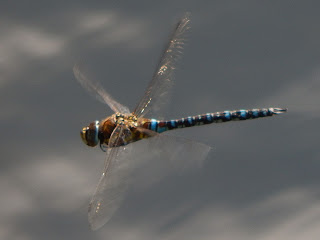 |
| The picture's not great but the Tree Sparrows are pretty good. |
The first part of the minor road between Benefield and Deenethorpe is one of my most reliable spots for Tree Sparrows and I'm happy to say that it did not disappoint me today. A flock of thirty plus included rather a lot of youngsters and they spent part of their time perched on the hedge tops. This area is also good for Brown Hares so it was not a surprise when I saw one racing across a ploughed field.
 |
| A trio of Teals. |
Conditions at this point were still on the gloomy side and this may have prompted a Tawny Owl to hoot a couple of times from within Burn Coppice. Between here and the village two flocks of Lapwings totalling over a hundred birds were seen. Further small parties were seen elsewhere during the day including at the inflow of Deene Lake. A pair of Ravens were also noted here while the field margins seemed full of both partridges and pheasants, how many of these will survive the next few months?
 |
| It's evidently a tiring business being a Snipe. |
At the Deene Lake inflow the water level remained high and duck numbers had increased with Gadwalls and a Wigeon joining the usual Teals and Mallards. As well as the Lapwings the Autumn's first Snipes had arrived with a brace of birds present. With time moving on I didn't visit the main lake and instead headed towards the airfield seeing the first of three Red Admirals on the way.
 |
| Red Kite. |
The sun was beginning to appear and this encouraged a few Small Whites out but apart from a pair of Hornets menacing the smaller stuff around some Ivy flowers that was it as far as insects went. There were a few Meadow Pipits around but a large group of Swallows and House Martins passing through provided most of the migrant interest. Some warblers are still about with Chiffchaff, Willow Warbler and Blackcap being noted.
 |
| Buzzard. |
Approaching Bears Lane a Buzzard perched nicely on the top of a hedgerow and another couple of Ravens could be heard croaking in Laundimer Woods. From the lane I scanned through a group of gulls but could not find anything too interesting though there were a few Lesser Black Backs associating with their smaller cousins.
 |
| The same Buzzard buzzing off. |
Yesterday was spent at an airshow at Duxford where amongst the selection of aeroplanes I managed to find some moths, a couple of hawks and a wildcat. A few pictures feature below.












































